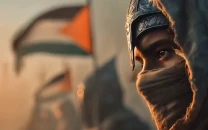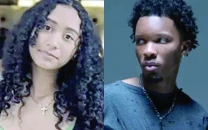Struggling to breathe
Art exhibition at Khaas Art Gallery portrays spiritual angst.

A pervasive feeling of fatalistic darkness — from which there is no escape — and spiritual torment dominates the current exhibition at Khaas Art Gallery, showcasing work from Karachi-based artist Syed Faraz Ali and his contemporaries from Thailand, Kriangkrai Konngkhanun and Panuwat Sitheechoke.
In both technique and subject matter, the three artists indicate that all is not well in the world; a nightmarish disturbance occupies their respective prints. We see malformed heads, demonic scenes, faces either shrouded in darkness or rendered with their mouths gaping open in a silent, wordless commitment to torment. “The whole thing is very dark,” says Alia Bilgrami, Assistant Curator at Khaas Gallery. “Basically, they’ve all used print making techniques but I think the underlying theme is the same. The artists are concerned with what’s going on in society, juxtaposing it with a sense of spiritual angst.”
Konngkhanun’s tactile woodcut prints — large, arresting, and totally horrifying — address a very contemporary malaise; a malaise of the soul. Hence, he appropriately titles two of his most dynamic woodcuts, ‘Spiritual Disease’. In one print, a ghastly dragon emerges from the headless form of a man in a black suit, barefoot and trapped within a scene of draconic creatures. In another, conjoined souls a la human-animal hybrids demonstrate a malformed spirituality — the eerie, demonic goat-heads evoking the devil’s presence. “The darkness crept in and hid itself. The pure soul was transformed and the self was devoured and dominated. Thus, spiritual disease was formed and spread,” explains the artist in a poetic statement.
Incidentally, Sitheechoke’s series of prints, titled ‘Reticular’, deal with similar subject matter, although more subtly rendered. From a distance, it’s the colour scheme that instantly grabs the viewer: a pleasant interplay between emerald-green hues, grey and black. Upon closer attention, the horror crystallises: a phantasmagoria of figures and faces trapped within mesh, engaged in silent and painful moaning. We think of the worst circle of hell. It is here.
“I use ‘reticulum’ as a pictorial symbol implying human ambition and struggle,” says Sitheechoke. “Human fate is closely associated with social rules which he is obliged to follow. As time passes by, these unquestioned rules make a person obsessed, in an unstable dimension of mind, and lose self-control.” Indeed, these are figures devoid of human-agency, swaddled in shadow and disquiet.
Meanwhile, our final artist takes deception to the next level in his silkscreen, sand and paper canvas prints. Portraits of young, juvenile expressions take precedence here. They look pleasant, almost happy. Yet the artist overlays the sprightly faces with a hazy, dark screen, veiling them behind a palette of despair in a stroke of technical brilliance. In fact, the technique implies his subject matter — the struggle he seeks to depict. A strong contrast emerges; a juxtaposition between the hues of despondency and a life brimming beneath the surface, struggling to emerge.
Published in The Express Tribune, December 3rd, 2011.



















COMMENTS
Comments are moderated and generally will be posted if they are on-topic and not abusive.
For more information, please see our Comments FAQ